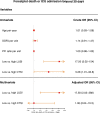Lung ultrasound and computed tomography to monitor COVID-19 pneumonia in critically ill patients: a two-center prospective cohort study
- PMID: 33491147
- PMCID: PMC7829056
- DOI: 10.1186/s40635-020-00367-3
Lung ultrasound and computed tomography to monitor COVID-19 pneumonia in critically ill patients: a two-center prospective cohort study
Abstract
Background: Lung ultrasound can adequately monitor disease severity in pneumonia and acute respiratory distress syndrome. We hypothesize lung ultrasound can adequately monitor COVID-19 pneumonia in critically ill patients.
Methods: Adult patients with COVID-19 pneumonia admitted to the intensive care unit of two academic hospitals who underwent a 12-zone lung ultrasound and a chest CT examination were included. Baseline characteristics, and outcomes including composite endpoint death or ICU stay > 30 days were recorded. Lung ultrasound and CT images were quantified as a lung ultrasound score involvement index (LUSI) and CT severity involvement index (CTSI). Primary outcome was the correlation, agreement, and concordance between LUSI and CTSI. Secondary outcome was the association of LUSI and CTSI with the composite endpoints.
Results: We included 55 ultrasound examinations in 34 patients, which were 88% were male, with a mean age of 63 years and mean P/F ratio of 151. The correlation between LUSI and CTSI was strong (r = 0.795), with an overall 15% bias, and limits of agreement ranging - 40 to 9.7. Concordance between changes in sequentially measured LUSI and CTSI was 81%. In the univariate model, high involvement on LUSI and CTSI were associated with a composite endpoint. In the multivariate model, LUSI was the only remaining independent predictor.
Conclusions: Lung ultrasound can be used as an alternative for chest CT in monitoring COVID-19 pneumonia in critically ill patients as it can quantify pulmonary involvement, register changes over the course of the disease, and predict death or ICU stay > 30 days.
Trial registration: NTR, NL8584. Registered 01 May 2020-retrospectively registered, https://www.trialregister.nl/trial/8584.
Keywords: Adult; COVID-19; Critical illness; Lung; Pneumonia; Respiratory distress syndrome; Ultrasonography.
Conflict of interest statement
The authors declare that they have no competing interests.
Figures



References
-
- Grasselli G, Pesenti A, Cecconi M. Critical Care Utilization for the COVID-19 Outbreak in Lombardy, Italy: Early Experience and Forecast during an Emergency Response. JAMA - J Am Med Assoc. Am Med Assoc. 2020;323:1545–1546. - PubMed
LinkOut - more resources
Full Text Sources
Other Literature Sources

